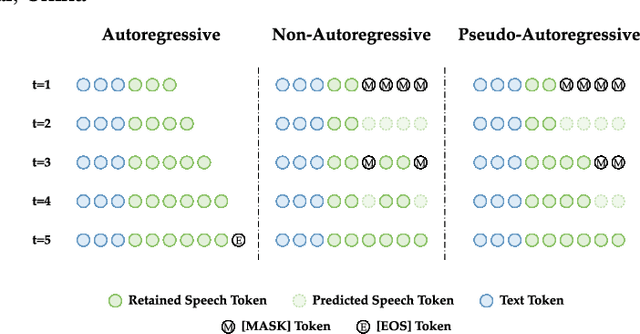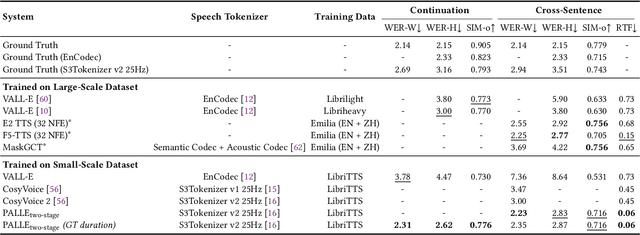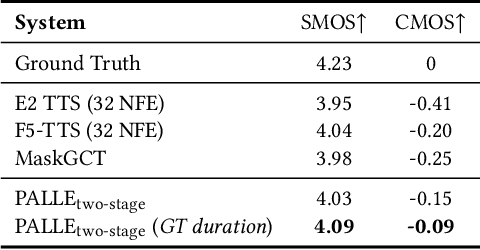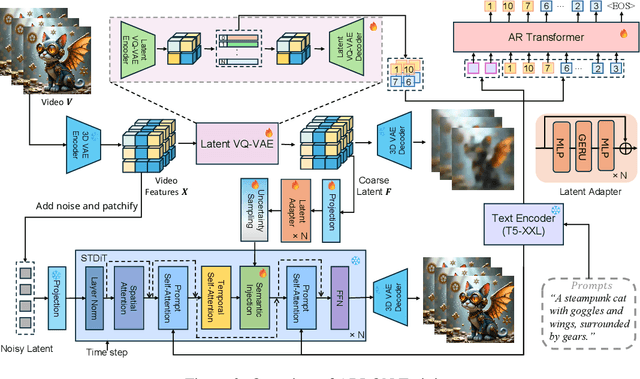Lingwei Meng
StreamMel: Real-Time Zero-shot Text-to-Speech via Interleaved Continuous Autoregressive Modeling
Jun 14, 2025Abstract:Recent advances in zero-shot text-to-speech (TTS) synthesis have achieved high-quality speech generation for unseen speakers, but most systems remain unsuitable for real-time applications because of their offline design. Current streaming TTS paradigms often rely on multi-stage pipelines and discrete representations, leading to increased computational cost and suboptimal system performance. In this work, we propose StreamMel, a pioneering single-stage streaming TTS framework that models continuous mel-spectrograms. By interleaving text tokens with acoustic frames, StreamMel enables low-latency, autoregressive synthesis while preserving high speaker similarity and naturalness. Experiments on LibriSpeech demonstrate that StreamMel outperforms existing streaming TTS baselines in both quality and latency. It even achieves performance comparable to offline systems while supporting efficient real-time generation, showcasing broad prospects for integration with real-time speech large language models. Audio samples are available at: https://aka.ms/StreamMel.
Towards One-bit ASR: Extremely Low-bit Conformer Quantization Using Co-training and Stochastic Precision
May 27, 2025Abstract:Model compression has become an emerging need as the sizes of modern speech systems rapidly increase. In this paper, we study model weight quantization, which directly reduces the memory footprint to accommodate computationally resource-constrained applications. We propose novel approaches to perform extremely low-bit (i.e., 2-bit and 1-bit) quantization of Conformer automatic speech recognition systems using multiple precision model co-training, stochastic precision, and tensor-wise learnable scaling factors to alleviate quantization incurred performance loss. The proposed methods can achieve performance-lossless 2-bit and 1-bit quantization of Conformer ASR systems trained with the 300-hr Switchboard and 960-hr LibriSpeech corpus. Maximum overall performance-lossless compression ratios of 16.2 and 16.6 times are achieved without a statistically significant increase in the word error rate (WER) over the full precision baseline systems, respectively.
Zero-Shot Streaming Text to Speech Synthesis with Transducer and Auto-Regressive Modeling
May 26, 2025Abstract:Zero-shot streaming text-to-speech is an important research topic in human-computer interaction. Existing methods primarily use a lookahead mechanism, relying on future text to achieve natural streaming speech synthesis, which introduces high processing latency. To address this issue, we propose SMLLE, a streaming framework for generating high-quality speech frame-by-frame. SMLLE employs a Transducer to convert text into semantic tokens in real time while simultaneously obtaining duration alignment information. The combined outputs are then fed into a fully autoregressive (AR) streaming model to reconstruct mel-spectrograms. To further stabilize the generation process, we design a Delete < Bos > Mechanism that allows the AR model to access future text introducing as minimal delay as possible. Experimental results suggest that the SMLLE outperforms current streaming TTS methods and achieves comparable performance over sentence-level TTS systems. Samples are available on https://anonymous.4open.science/w/demo_page-48B7/.
Dynamic Uncertainty Learning with Noisy Correspondence for Text-Based Person Search
May 10, 2025Abstract:Text-to-image person search aims to identify an individual based on a text description. To reduce data collection costs, large-scale text-image datasets are created from co-occurrence pairs found online. However, this can introduce noise, particularly mismatched pairs, which degrade retrieval performance. Existing methods often focus on negative samples, amplifying this noise. To address these issues, we propose the Dynamic Uncertainty and Relational Alignment (DURA) framework, which includes the Key Feature Selector (KFS) and a new loss function, Dynamic Softmax Hinge Loss (DSH-Loss). KFS captures and models noise uncertainty, improving retrieval reliability. The bidirectional evidence from cross-modal similarity is modeled as a Dirichlet distribution, enhancing adaptability to noisy data. DSH adjusts the difficulty of negative samples to improve robustness in noisy environments. Our experiments on three datasets show that the method offers strong noise resistance and improves retrieval performance in both low- and high-noise scenarios.
Pseudo-Autoregressive Neural Codec Language Models for Efficient Zero-Shot Text-to-Speech Synthesis
Apr 14, 2025



Abstract:Recent zero-shot text-to-speech (TTS) systems face a common dilemma: autoregressive (AR) models suffer from slow generation and lack duration controllability, while non-autoregressive (NAR) models lack temporal modeling and typically require complex designs. In this paper, we introduce a novel pseudo-autoregressive (PAR) codec language modeling approach that unifies AR and NAR modeling. Combining explicit temporal modeling from AR with parallel generation from NAR, PAR generates dynamic-length spans at fixed time steps. Building on PAR, we propose PALLE, a two-stage TTS system that leverages PAR for initial generation followed by NAR refinement. In the first stage, PAR progressively generates speech tokens along the time dimension, with each step predicting all positions in parallel but only retaining the left-most span. In the second stage, low-confidence tokens are iteratively refined in parallel, leveraging the global contextual information. Experiments demonstrate that PALLE, trained on LibriTTS, outperforms state-of-the-art systems trained on large-scale data, including F5-TTS, E2-TTS, and MaskGCT, on the LibriSpeech test-clean set in terms of speech quality, speaker similarity, and intelligibility, while achieving up to ten times faster inference speed. Audio samples are available at https://anonymous-palle.github.io.
$C^2$AV-TSE: Context and Confidence-aware Audio Visual Target Speaker Extraction
Apr 01, 2025Abstract:Audio-Visual Target Speaker Extraction (AV-TSE) aims to mimic the human ability to enhance auditory perception using visual cues. Although numerous models have been proposed recently, most of them estimate target signals by primarily relying on local dependencies within acoustic features, underutilizing the human-like capacity to infer unclear parts of speech through contextual information. This limitation results in not only suboptimal performance but also inconsistent extraction quality across the utterance, with some segments exhibiting poor quality or inadequate suppression of interfering speakers. To close this gap, we propose a model-agnostic strategy called the Mask-And-Recover (MAR). It integrates both inter- and intra-modality contextual correlations to enable global inference within extraction modules. Additionally, to better target challenging parts within each sample, we introduce a Fine-grained Confidence Score (FCS) model to assess extraction quality and guide extraction modules to emphasize improvement on low-quality segments. To validate the effectiveness of our proposed model-agnostic training paradigm, six popular AV-TSE backbones were adopted for evaluation on the VoxCeleb2 dataset, demonstrating consistent performance improvements across various metrics.
Next Token Prediction Towards Multimodal Intelligence: A Comprehensive Survey
Dec 30, 2024



Abstract:Building on the foundations of language modeling in natural language processing, Next Token Prediction (NTP) has evolved into a versatile training objective for machine learning tasks across various modalities, achieving considerable success. As Large Language Models (LLMs) have advanced to unify understanding and generation tasks within the textual modality, recent research has shown that tasks from different modalities can also be effectively encapsulated within the NTP framework, transforming the multimodal information into tokens and predict the next one given the context. This survey introduces a comprehensive taxonomy that unifies both understanding and generation within multimodal learning through the lens of NTP. The proposed taxonomy covers five key aspects: Multimodal tokenization, MMNTP model architectures, unified task representation, datasets \& evaluation, and open challenges. This new taxonomy aims to aid researchers in their exploration of multimodal intelligence. An associated GitHub repository collecting the latest papers and repos is available at https://github.com/LMM101/Awesome-Multimodal-Next-Token-Prediction
Interleaved Speech-Text Language Models are Simple Streaming Text to Speech Synthesizers
Dec 23, 2024Abstract:This paper introduces Interleaved Speech-Text Language Model (IST-LM) for streaming zero-shot Text-to-Speech (TTS). Unlike many previous approaches, IST-LM is directly trained on interleaved sequences of text and speech tokens with a fixed ratio, eliminating the need for additional efforts in duration prediction and grapheme-to-phoneme alignment. The ratio of text chunk size to speech chunk size is crucial for the performance of IST-LM. To explore this, we conducted a comprehensive series of statistical analyses on the training data and performed correlation analysis with the final performance, uncovering several key factors: 1) the distance between speech tokens and their corresponding text tokens, 2) the number of future text tokens accessible to each speech token, and 3) the frequency of speech tokens precedes their corresponding text tokens. Experimental results demonstrate how to achieve an optimal streaming TTS system without complicated engineering optimization, which has a limited gap with the non-streaming system. IST-LM is conceptually simple and empirically powerful, paving the way for streaming TTS with minimal overhead while largely maintaining performance, showcasing broad prospects coupled with real-time text stream from LLMs.
ARLON: Boosting Diffusion Transformers with Autoregressive Models for Long Video Generation
Oct 27, 2024



Abstract:Text-to-video models have recently undergone rapid and substantial advancements. Nevertheless, due to limitations in data and computational resources, achieving efficient generation of long videos with rich motion dynamics remains a significant challenge. To generate high-quality, dynamic, and temporally consistent long videos, this paper presents ARLON, a novel framework that boosts diffusion Transformers with autoregressive models for long video generation, by integrating the coarse spatial and long-range temporal information provided by the AR model to guide the DiT model. Specifically, ARLON incorporates several key innovations: 1) A latent Vector Quantized Variational Autoencoder (VQ-VAE) compresses the input latent space of the DiT model into compact visual tokens, bridging the AR and DiT models and balancing the learning complexity and information density; 2) An adaptive norm-based semantic injection module integrates the coarse discrete visual units from the AR model into the DiT model, ensuring effective guidance during video generation; 3) To enhance the tolerance capability of noise introduced from the AR inference, the DiT model is trained with coarser visual latent tokens incorporated with an uncertainty sampling module. Experimental results demonstrate that ARLON significantly outperforms the baseline OpenSora-V1.2 on eight out of eleven metrics selected from VBench, with notable improvements in dynamic degree and aesthetic quality, while delivering competitive results on the remaining three and simultaneously accelerating the generation process. In addition, ARLON achieves state-of-the-art performance in long video generation. Detailed analyses of the improvements in inference efficiency are presented, alongside a practical application that demonstrates the generation of long videos using progressive text prompts. See demos of ARLON at \url{http://aka.ms/arlon}.
Towards Within-Class Variation in Alzheimer's Disease Detection from Spontaneous Speech
Sep 22, 2024



Abstract:Alzheimer's Disease (AD) detection has emerged as a promising research area that employs machine learning classification models to distinguish between individuals with AD and those without. Unlike conventional classification tasks, we identify within-class variation as a critical challenge in AD detection: individuals with AD exhibit a spectrum of cognitive impairments. Given that many AD detection tasks lack fine-grained labels, simplistic binary classification may overlook two crucial aspects: within-class differences and instance-level imbalance. The former compels the model to map AD samples with varying degrees of impairment to a single diagnostic label, disregarding certain changes in cognitive function. While the latter biases the model towards overrepresented severity levels. This work presents early efforts to address these challenges. We propose two novel methods: Soft Target Distillation (SoTD) and Instance-level Re-balancing (InRe), targeting two problems respectively. Experiments on the ADReSS and ADReSSo datasets demonstrate that the proposed methods significantly improve detection accuracy. Further analysis reveals that SoTD effectively harnesses the strengths of multiple component models, while InRe substantially alleviates model over-fitting. These findings provide insights for developing more robust and reliable AD detection models.
 Add to Chrome
Add to Chrome Add to Firefox
Add to Firefox Add to Edge
Add to Edge